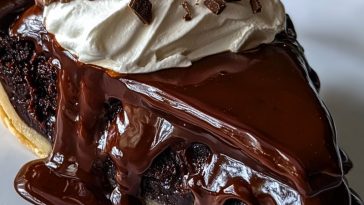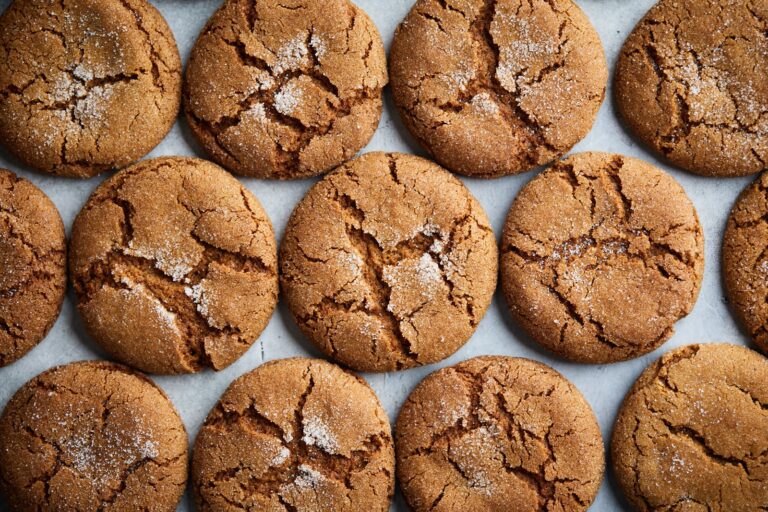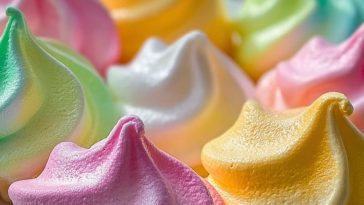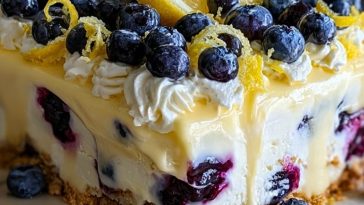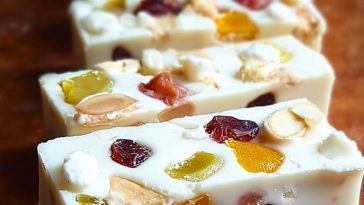Sugar Cookie Cheesecake – Creamy, Festive & Irresistible
There’s something magical about a dessert that blends the familiar comfort of sugar cookies with the creamy indulgence of cheesecake. When I first made this Sugar Cookie Cheesecake, I realized instantly it wasn’t just another holiday treat—it was a showstopper. The buttery cookie base, the silky cheesecake center, and the sweet topping all came together in a way that tasted like Christmas wrapped in every slice. Each bite has that perfect balance of soft and crunchy, creamy and sweet, making it unforgettable.
What I love most about this recipe is how festive and versatile it feels. It’s elegant enough to bring to a holiday gathering, yet cozy enough to enjoy with family on a winter evening by the tree. The sugar cookie crust gives it a nostalgic charm, while the cheesecake filling turns it into something worthy of celebration. Whether you make it for Christmas dinner, a cookie exchange, or just because you want a dessert that feels warm and special, this recipe guarantees smiles.
Why You’ll Love This Sugar Cookie Cheesecake
This cheesecake isn’t your ordinary holiday dessert. It combines two favorites—cookies and cheesecake—into one irresistible dish. The sugar cookie crust adds a unique sweetness that pairs beautifully with the creamy filling. It’s simple enough for beginner bakers, but impressive enough to be the centerpiece of any dessert table. Each layer works together: the crust gives crunch, the cheesecake gives creaminess, and the topping brings everything full circle.
Another reason you’ll love this is how well it fits into Christmas traditions. Sugar cookies are a holiday staple, and cheesecake feels like a treat for special occasions. Together, they create a dessert that feels comforting, nostalgic, and exciting all at once. Plus, it slices beautifully, which makes it ideal for serving guests without stress.
What Kind of Cookies Should I Use for Sugar Cookie Cheesecake?
For the base of this cheesecake, you’ll want to use classic sugar cookies. A homemade batch with a soft center and crisp edges works beautifully, but store-bought sugar cookies will save time and still taste great. Make sure they’re not too soft or frosted—you need that firm texture to hold up as a crust. If using homemade, bake them a little longer so they’re sturdy enough to be crushed without turning gummy.
Pre-packaged sugar cookie dough is another great option. You can roll it out and bake a thick crust layer instead of using crumbs. Just remember to let it cool fully before adding the cheesecake filling, otherwise the heat can cause cracks or separation.
Options for Substitutions
One of the best things about baking is how flexible recipes can be, and this cheesecake is no different. If you don’t have certain ingredients or want to tailor the dessert to your tastes, there are plenty of easy swaps.
Ingredients for Sugar Cookie Cheesecake

Step-by-Step Instructions
Step 1: Prepare the Cookie Crust
Crush the sugar cookies into fine crumbs using a food processor or by sealing them in a bag and rolling with a rolling pin. Mix the crumbs with melted butter until evenly coated. Press this mixture firmly into the bottom of a springform pan to create a solid crust. Chill it in the refrigerator while you prepare the filling.
Step 2: Make the Cheesecake Filling
In a large mixing bowl, beat the cream cheese until smooth and creamy. Add sugar, sour cream, and vanilla extract, mixing until combined. One at a time, add the eggs, beating on low speed just until incorporated. This prevents too much air from entering the batter, which can cause cracks.
Step 3: Assemble the Cheesecake
Pour the cheesecake filling over the chilled cookie crust, smoothing the top with a spatula. Tap the pan gently on the counter to release any air bubbles.
Step 4: Bake the Cheesecake
Preheat the oven and place the cheesecake pan inside a larger roasting pan. Fill the roasting pan with hot water halfway up the cheesecake pan to create a water bath. Bake until the edges are set but the center still jiggles slightly when moved.
Step 5: Cool Gradually
Turn off the oven and crack the door open, letting the cheesecake cool slowly for about an hour. This helps prevent cracks on the surface. Afterward, transfer it to the refrigerator and let it chill for at least 4 hours or overnight for the best texture.
Step 6: Add Toppings and Serve
Once chilled, top the cheesecake with powdered sugar, whipped cream, or any festive garnish of your choice. Slice carefully with a sharp knife, wiping clean between cuts, and serve each slice with holiday cheer.
How Long to Bake Sugar Cookie Cheesecake
Timing is one of the most important parts of baking a cheesecake, and sugar cookie cheesecake is no exception. If you underbake it, the filling won’t hold its shape and will collapse when sliced. If you overbake it, you’ll end up with a dry, grainy texture that’s nothing like the creamy indulgence you’re aiming for.
Generally, this cheesecake needs to bake for about 55–65 minutes at 325°F (163°C), but there are several signs to look for beyond the clock:
Remember, cheesecake continues to set as it cools and chills, so resist the temptation to leave it in the oven longer than needed. Patience with cooling and chilling is the real secret to that perfect creamy slice.
Tips for the Perfect Sugar Cookie Cheesecake
Getting cheesecake just right can feel intimidating, but following a few smart tips ensures success every time:
Watch Out for These Mistakes
Even experienced bakers sometimes run into cheesecake mishaps. Here are the most common pitfalls with sugar cookie cheesecake—and how to avoid them:
What to Serve With Sugar Cookie Cheesecake?
This Sugar Cookie Cheesecake is delicious on its own, but pairing it with complementary flavors and textures can take it to the next level. Try serving it with:
Whether you keep it simple or dress it up with sides, this cheesecake always feels like the star of the table.
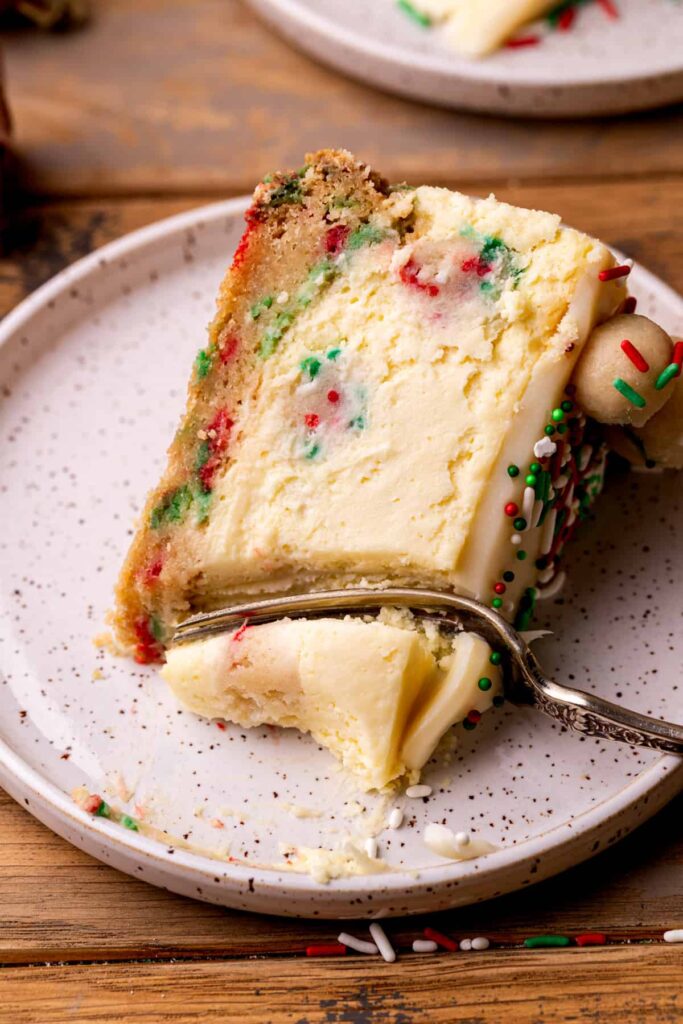
Storage Instructions
Sugar Cookie Cheesecake stores surprisingly well if handled properly, which makes it an ideal make-ahead dessert for busy holidays.
Estimated Nutrition (Per Serving – Based on 12 Servings)
|
Calories |
410 |
|
Protein |
7g |
|
Fat |
27g |
|
Saturated Fat |
16g |
|
Carbohydrates |
36g |
|
Sugar |
28g |
|
Cholesterol |
45mg |
|
Sodium |
150mg |
Frequently Asked Questions
Conclusion
Sugar Cookie Cheesecake is the kind of dessert that brings holiday magic straight to your table. It combines two classics into one decadent dish, giving you the nostalgia of cookies and the elegance of cheesecake in every bite. With its golden crust, creamy filling, and festive toppings, it’s guaranteed to be a centerpiece-worthy treat this Christmas season. Whether you’re serving it at a family dinner, gifting it to friends, or enjoying it by the fireplace, this cheesecake delivers comfort, cheer, and a little extra sparkle to your holiday celebrations.

